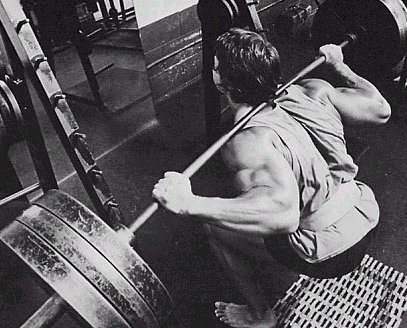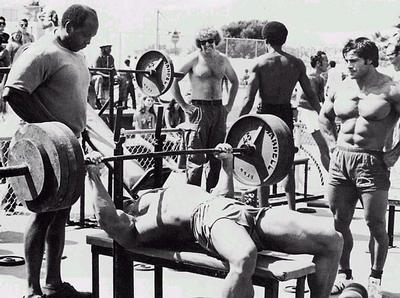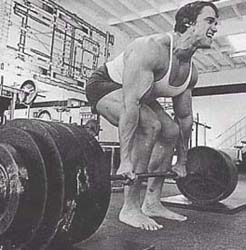Full Body Compound Work-out
Full Body Compound Work-out
 Numerous studies have indicated that weight training exercises that recruit large muscle masses (i.e. the compound exercises) result in the largest anabolic hormonal response by the body. The proportions of anabolic hormones (mainly growth hormone and testosterone) secreted are thought to be functions of factors such as total muscle mass recuited, exercise intensity, rep count and rest between sets - with lower rep sets and longer breaks between them favoring testosterone release and higher rep sets and shorter breaks between them favoring growth hormone (hGH). The more total muscle mass involved, the higher the hormone levels rise. For this reason, Squats will cause a greater hormonal response than Bench Presses.
Numerous studies have indicated that weight training exercises that recruit large muscle masses (i.e. the compound exercises) result in the largest anabolic hormonal response by the body. The proportions of anabolic hormones (mainly growth hormone and testosterone) secreted are thought to be functions of factors such as total muscle mass recuited, exercise intensity, rep count and rest between sets - with lower rep sets and longer breaks between them favoring testosterone release and higher rep sets and shorter breaks between them favoring growth hormone (hGH). The more total muscle mass involved, the higher the hormone levels rise. For this reason, Squats will cause a greater hormonal response than Bench Presses.
These are exercises that involve more than one major muscle and involve the movement of move than one joint. Examples would be Squats, Bent-Over Rows, Bench Presses, Military Presses, and so on. The collective experience of generations of weight trainers teaches that these are the most effective movements for producing gains in strength and muscle size.
These are exercises like squats, deadlifts, bench presses, chins, dips and rows. They cause a release of a lot more anabolic hormones than isolation exercises like concentration curls, cable crossovers, leg extensions, etc. Consequently, they cause a lot more muscular growth.
Compound exercises are recommended on and off cycles. They are strength building exercises. when off the anabolic steroids they can increase your output of testosterone and growth hormones naturally. That’s why Old School Bodybuilders used this trainings regimen.
The dead lift for example hits just about every muscle in your body. So it strengthens all the muscles it hits. The importance of it while on a cycle is because the steroids will increase the strength of a muscle. While on the anabolic steroids the strength increases so fast tendons and ligaments find it hard to catch up because there are virtually no blood vessels in them. To do a compound exercise it hits also the stabilizing muscles around the major muscles and it turn helps take stress off the tendons and ligaments. It practacly strengthen the exercised muscles and all surrounding muscles used to stabilise the body when by example standing up when dead-lifting.
I was pondering this the other day and realized that every single time I made the greatest gains of my training career, it was with full-body workouts using the big compound exercises.
It just makes sense.
Since it has been proven that a compound exercise like deadlifts stimulates a much greater release of anabolic hormones than an isolation exercise... wouldn't an entire workout of compound exercises stimulate and even greater increase in those anabolic hormones?
So what's the success formula?
Simple. A full-body workout done two to three times a week, using compound exercises.
Incorporate these compound exercises into your workout and see the difference they make.
If you have been lifting for several months and just haven’t been seeing the results that you were hoping for, then there could very well be a number of things causing it. One of the most common culprits for a lack of progression is your training program, or rather what exercises make up your training program. Strength training exercises can effectively by put into two separate groups: compound and isolation lifts. An isolation lift is exactly what it sounds like, it is an exercise that singles out one muscle, whereas a compound lift will train several muscles at once. It is almost universally accepted that compound lifts will deliver the best results for any bodybuilder, this is exactly why one should build their training routine around compound lifts. With that in mind, we are going to be reviewing 5 of the best compound exercises around for a bodybuilder, powerlifter or athlete.
 SQUATS
SQUATS
Most bodybuilders have a love/hate relationship with squats. If you’re looking to build lower-body mass, there really is no better exercise out there than the squat. But at the same time, squats can be extremely strenuous and taxing on the body. Proper form for a squat is essential, as doing the exercise incorrectly could put you at risk for a serious injury. The back should remain straight at all times during the exercise, and the trainer should squat down to at least where their knees form a 90 degree angle. If you aren’t comfortable with the exercise yet, get a friend to watch your form while you practice with an unloaded bar. Eventually you will get the motion down and it will become second nature to you, but it is imperative to learn the proper form early on.
PULL-UPS
 A common misconception that some people have with compound exercises is that they can only be done with equipment- like how a deadlift requires a barbell and weight. This is not the case, as one of the most effective exercises for upper body mass requires nothing more than your own bodyweight and that is the pull up. Just as there are different forms of the squat exercise, you will note that there are also different forms of pull ups, with varying grips for the user to hold on to, with each stressing a different muscle group. For example, grips where your palms face towards each other will emphasize your biceps, where if your palms are facing away from your body, it will be more for your back. Make sure that you choose a grip that is in line with both your goals are and what you feel comfortable with. As you progress with your pull-ups you’ll also be able to add more weight with a weight belt and continue to push yourself past your limits.
A common misconception that some people have with compound exercises is that they can only be done with equipment- like how a deadlift requires a barbell and weight. This is not the case, as one of the most effective exercises for upper body mass requires nothing more than your own bodyweight and that is the pull up. Just as there are different forms of the squat exercise, you will note that there are also different forms of pull ups, with varying grips for the user to hold on to, with each stressing a different muscle group. For example, grips where your palms face towards each other will emphasize your biceps, where if your palms are facing away from your body, it will be more for your back. Make sure that you choose a grip that is in line with both your goals are and what you feel comfortable with. As you progress with your pull-ups you’ll also be able to add more weight with a weight belt and continue to push yourself past your limits.
 DIPS
DIPS
Dips can be seen as the sort of “triceps version” of the pull-up- both require the user to use their own bodyweight for the lift, and both require no gym equipment to perform. Dips are a great way to strengthen and develop your triceps, and should be a part of any bodybuilder’s routine because of how easy they are to do, and how there is far less risk for injury compared to some of the other lifts covered in this article. Also like pull-ups, you should eventually get to the point where they become rather easy for you, in which it is time to graduate to the weighted dips, which is essentially the same thing, but you are just wearing a weighted belt for more counterweight.
BENCH PRESS
 There is perhaps no more overused exercise in bodybuilding than the benchpress. If you go to a big gym at a busy time of the day, chances are you are going to have to wait to get a benchpress station to yourself, as it is one of those lifts that people just can’t seem to live without. Even though the benchpress is usually done far too often than it needs to be, this doesn’t mean that it isn’t a very effective exercise for your chest. Because the benchpress is something of a “show-off” lift, people will often sacrifice their form of the exercise to make sure they are doing a lot of weight. If you take nothing else away from this article, at least remember that using poor form on the benchpress is a huge mistake, even if it means adding a couple pounds to your lift. Not only will this put you at risk for serious injuries, but it will also impede (or stop altogether) your gains from the lift. Start out nice and light and make sure you are positive that your form is correct- only then should you start adding on the heavy weight.
There is perhaps no more overused exercise in bodybuilding than the benchpress. If you go to a big gym at a busy time of the day, chances are you are going to have to wait to get a benchpress station to yourself, as it is one of those lifts that people just can’t seem to live without. Even though the benchpress is usually done far too often than it needs to be, this doesn’t mean that it isn’t a very effective exercise for your chest. Because the benchpress is something of a “show-off” lift, people will often sacrifice their form of the exercise to make sure they are doing a lot of weight. If you take nothing else away from this article, at least remember that using poor form on the benchpress is a huge mistake, even if it means adding a couple pounds to your lift. Not only will this put you at risk for serious injuries, but it will also impede (or stop altogether) your gains from the lift. Start out nice and light and make sure you are positive that your form is correct- only then should you start adding on the heavy weight.
DEADLIFT
N o true compound lifting routine is complete without the deadlift, and for that reason it makes an easy addition to this list. The deadlift completes the perfect triad of compound lifts- the other two being the equally important squat and benchpress. Like the squat, the deadlift exercises a plethora of muscles, and is incredibly strenuous on the body when done correctly. Also like the squat, the risk of following incorrect form is high, and carries some pretty serious consequences. By starting with an empty barbell and looking at your form in the mirror, you should get a pretty good idea of whether or not you are doing the lift correctly. Although we could go on for days about what muscle groups it trains, it is most effective for strengthening the core, back and hamstrings.
o true compound lifting routine is complete without the deadlift, and for that reason it makes an easy addition to this list. The deadlift completes the perfect triad of compound lifts- the other two being the equally important squat and benchpress. Like the squat, the deadlift exercises a plethora of muscles, and is incredibly strenuous on the body when done correctly. Also like the squat, the risk of following incorrect form is high, and carries some pretty serious consequences. By starting with an empty barbell and looking at your form in the mirror, you should get a pretty good idea of whether or not you are doing the lift correctly. Although we could go on for days about what muscle groups it trains, it is most effective for strengthening the core, back and hamstrings.
Here's a sample workout done on Monday, Wednesday and Friday. You should be able to get this done in an hour or less.
Overhead Dumbbell or Barbell Press: 2 sets of 8 to 10 reps
Squats: 3 sets of 8 to 12 reps
Barbell or Dumbbell Flat Bench Press: 3 sets of 8 reps
Chins or Bent Over Barbell Rows: 3 sets of 8 to 12 reps
Dips or Close Grip Bench Press: 1 to 2 sets of 8 reps
Barbell or Dumbbell Curls: 1 to 2 sets of 8 reps
Standing or Donkey Calf Raises: 2 to 3 sets of 12 to 20 reps
You should do a couple lighter warm up sets prior to your work sets. All work sets should be worked very hard. In other words, the very last rep should be the last one you are capable of doing. Increase the weight used in small increments as often as possible
- Login to post comments


